When it comes to straightening your teeth, braces are a tried and true method that has been helping people achieve beautiful smiles for decades. But with advancements in technology and materials, there are now more options than ever before. Two popular choices for braces are metal and ceramic braces.
In this article, we’ll explore the main differences between metal and ceramic braces and help you determine which type may be best for you. So, let’s dive in and get all the facts before making a decision on your orthodontic treatment. Let’s compare metal vs. ceramic braces.
What Are Metal Braces?
Metal braces, also known as traditional braces, are the most common type of braces used by orthodontists. They consist of metal brackets that are attached to the teeth and connected by wires. These wires are then tightened at regular intervals to gradually shift the teeth into their desired position.
Metal braces may also come with different colored elastics, allowing for some customization and personalization. They are typically made of stainless steel, but can also be made with titanium.
What Are Ceramic Braces?
Ceramic braces are similar to metal braces in terms of structure and function, but with one major difference – the brackets are made of clear or tooth-colored ceramic material instead of metal. This makes them less noticeable and more aesthetically pleasing compared to traditional metal braces.
The wires used may also be tooth-colored for an even more discreet look. Ceramic braces are a popular choice for those who want a more subtle option for their orthodontic treatment.
Material
Metal braces are typically made of stainless steel or titanium, which are known for their strength and durability. This makes them a reliable option for effectively moving teeth into their desired position.
On the other hand, ceramic braces use clear or tooth-colored ceramic material, making them less noticeable than metal braces.
Visibility
In comparing metal vs ceramic braces, metal braces are more noticeable due to their use of metal brackets and wires, making them a less discreet option for orthodontic treatment.
On the other hand, ceramic braces are much less visible due to their clear or tooth-colored material, making them a popular choice for those who want a more subtle look.
Durability and Strength
Less frequent breaks or repairs are required since the wires’ pressure and strain can be withstood by the stainless steel or titanium used in their construction.
However, because ceramic braces are made of ceramic material, they could not last as long as metal braces. Particularly if a person does contact sports or has specific dietary habits, this may make them more prone to chipping or cracking.
Learn More About Metal vs. Ceramic Braces
In conclusion, the materials, visibility, and durability of metal and ceramic braces differ significantly from one another. The ideal set of braces for you will ultimately rely on your tastes and needs, so talk to your orthodontist to make an informed choice.
You now know everything there is to know about metal vs. ceramic braces. Decide which kind is perfect for you right now! You’ll be well on your way to developing a straighter and
Was this article useful to you? For more, see the rest of our blog!
